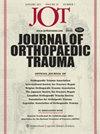Characteristics and Outcomes of Occult Infections in Presumed Aseptic Nonunions: A Retrospective Cohort Study
IF 1.6
3区 医学
Q3 ORTHOPEDICS
引用次数: 0
Abstract
To determine (1) the rate of positive cultures in presumed aseptic nonunions, (2) the rate and microbial spectrum of positive cultures that represented occult infection, and (3) rates of nonunion healing. Retrospective cohort study. Tertiary referral center. Adult patients with a presumed aseptic nonunion treated with single-stage revision between 2002 and 2022. The rate of positive cultures compared for two protocols: old: 1 – 2 samples cultured 7 days vs. new: 5 samples cultured 14 days. The rate of positive cultures meeting occult infection criteria with the new protocol (≥ 2 samples with phenotypically indistinguishable microorganisms, or ≥1 sample with a high virulent microorganism). Nonunion healing rates between protocols and between groups based on culture results with the new protocol. 179 patients were included. The rate of positive cultures was 14% (n = 15/105) with the old protocol, and 51% (n = 38/74) with the new protocol (p < 0.001). With the new protocol, the rate of positive cultures meeting occult infection criteria was 19% (n = 14/74), and Coagulase-negative staphylococci (48%) and Cutibacterium acnes (38%) were the most common microorganisms. Nonunion healing rates after the primary revision did not differ between protocols (old: 82% vs. new: 86%, p = 0.41) and groups based on culture result (sterile: 86% vs. occultly infected: 93%, p = 0.66). The final overall nonunion healing rate was 97%. Occult infections were identified in 1 in 5 presumed aseptic nonunions using a standardized protocol with 5 intraoperative samples cultured 14 days, and were predominantly caused by slow growing, gram-positive microorganisms. The local spectrum and antimicrobial sensitivity of occult infections should be considered when developing empiric antimicrobial protocols. Patients with presumed aseptic nonunions can expect high healing rates regardless of the culture result. Diagnostic Level III. See Instructions for Authors for a complete description of levels of evidence.假定无菌性无脓肿隐匿性感染的特征和结果:回顾性队列研究
目的:确定(1)假定的无菌性骨折中培养阳性率,(2)代表隐性感染的培养阳性率和微生物谱,以及(3)骨折愈合率。 回顾性队列研究。 三级转诊中心。 2002 年至 2022 年间接受单期翻修治疗的假定无菌性骨折成人患者。 比较两种方案的阳性培养率:旧方案:7 天培养 1 - 2 个样本;新方案:14 天培养 5 个样本。符合新方案隐性感染标准的培养阳性率(≥2个样本中含有表型无法区分的微生物,或≥1个样本中含有高毒力微生物)。根据新方案的培养结果,计算不同方案间和不同组间的不愈合率。 共纳入 179 例患者。旧方案的培养阳性率为 14%(n = 15/105),新方案为 51%(n = 38/74)(p < 0.001)。在新方案中,符合隐性感染标准的培养阳性率为 19%(n = 14/74),凝固酶阴性葡萄球菌(48%)和痤疮杆菌(38%)是最常见的微生物。根据培养结果(无菌:86% 对隐性感染:93%,P = 0.66),不同方案(旧方案:82% 对新方案:86%,P = 0.41)和不同组别在初次翻修后的不愈合率没有差异。最终的总体不愈合率为 97%。 采用标准化方案,对 5 份术中样本进行 14 天培养,发现每 5 个假定无菌性骨不连中就有 1 个存在隐匿性感染,且主要由生长缓慢的革兰氏阳性微生物引起。在制定经验性抗菌方案时,应考虑隐性感染的局部谱系和抗菌药物敏感性。无论培养结果如何,假定为无菌性骨髁非愈合的患者都可期待较高的愈合率。 诊断级别 III。有关证据等级的完整描述,请参阅 "作者须知"。
本文章由计算机程序翻译,如有差异,请以英文原文为准。
求助全文
约1分钟内获得全文
求助全文
来源期刊

Journal of Orthopaedic Trauma
医学-运动科学
CiteScore
3.90
自引率
8.70%
发文量
396
审稿时长
3-8 weeks
期刊介绍:
Journal of Orthopaedic Trauma is devoted exclusively to the diagnosis and management of hard and soft tissue trauma, including injuries to bone, muscle, ligament, and tendons, as well as spinal cord injuries. Under the guidance of a distinguished international board of editors, the journal provides the most current information on diagnostic techniques, new and improved surgical instruments and procedures, surgical implants and prosthetic devices, bioplastics and biometals; and physical therapy and rehabilitation.
 求助内容:
求助内容: 应助结果提醒方式:
应助结果提醒方式:


